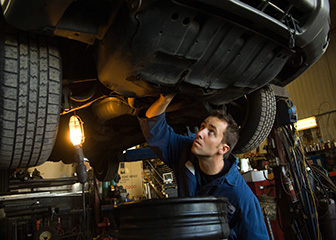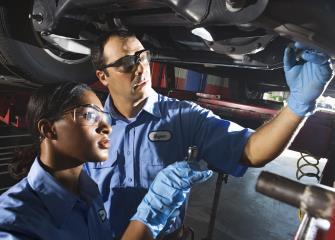Summary
Please enable javascript to play this video.
| Quick Facts: Automotive Service Technicians and Mechanics | |
|---|---|
|
$49,670 per year
$23.88 per hour |
|
| Postsecondary nondegree award | |
| None | |
| Short-term on-the-job training | |
| 805,600 | |
| 4% (As fast as average) | |
| 33,600 | |
What Automotive Service Technicians and Mechanics Do
Automotive service technicians and mechanics inspect, maintain, and repair cars and light trucks.
Work Environment
Automotive service technicians and mechanics usually work in well-ventilated and well-lit repair shops. Although technicians often identify and fix automotive problems with computers, they commonly work with greasy parts and tools, sometimes in uncomfortable positions. Most work full-time, which may include evenings or weekends.
How to Become an Automotive Service Technician or Mechanic
Automotive service technicians and mechanics typically complete a program in automotive service technology or a related field. However, some workers enter the occupation with a high school diploma and learn on the job. Certification may be required.
Pay
The median annual wage for automotive service technicians and mechanics was $49,670 in May 2024.
Job Outlook
Employment of automotive service technicians and mechanics is projected to grow 4 percent from 2024 to 2034, about as fast as the average for all occupations.
About 70,000 openings for automotive service technicians and mechanics are projected each year, on average, over the decade. Many of those openings are expected to result from the need to replace workers who transfer to different occupations or exit the labor force, such as to retire.
State & Area Data
Explore resources for employment and wages by state and area for automotive service technicians and mechanics.
Similar Occupations
Compare the job duties, education, job growth, and pay of automotive service technicians and mechanics with similar occupations.
More Information, Including Links to O*NET
Learn more about automotive service technicians and mechanics by visiting additional resources, including O*NET, a source on key characteristics of workers and occupations.
 United States Department of Labor
United States Department of Labor







